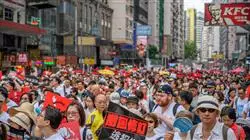University certificate
The world's largest faculty of journalism and communication”
Introduction to the Program
This complete Postgraduate diploma will help you to move with the efficacy of a program on the complete system of Political Communication”

The role of the journalist is important because, from a critical point of view, they are in charge of informing society of what is happening and occurring within the government and everything related to future decisions, maintaining relationships and connections within the government that allow them to obtain information.
In this way, the role of the journalist seeks, through communication, to establish relationships with high-level leaders in order to access a dialogue that allows them to transparently show everything that arises in politics and public institutions. In this way, the information will be more effective and truthful.
On the other hand, if the journalist is part of one of the public institutions or of the government itself, it is their duty to exercise their role, defending from a critical point of view their professional ethics to tell the truth of what is happening, but at the same time without losing those connections that in one way or another provide them with research material.
This Postgraduate diploma with 100% online format is a TECH course for all professional journalists who wish to expand their knowledge in the political sector. With its educational, audiovisual and innovative material, this program offers the latest up-to-date knowledge in the field of politics.
The experience of a solvent and expert university is available to you in this complete program”
This Postgraduate diploma in Political Communication contains the most complete and up-to-date educational program on the market. The most important features include:
- The latest technology in online teaching software
- A highly visual teaching system, supported by graphic and schematic contents that are easy to assimilate and understand
- Practical cases presented by practising experts
- State-of-the-art interactive video systems
- Teaching suppoarted by telepractice
- Continuous updating and recycling systems
- Autonomous learning: full compatibility with other occupations
- Practical exercises for self-evaluation and learning verification
- Support groups and educational synergies: questions to the expert, debate and knowledge forums
- Communication with the teacher and individual reflection work
- Content that is accessible from any fixed or portable device with an Internet connection
- Supplementary documentation databases are permanently available, even after the program
A Postgraduate diploma supported by the best technology, which will allow you to learn in a fluent and efficient way”
Or teaching staff is made up of practising specialists. A multidisciplinary team of trained and experienced professionals in different environments, who will develop the theoretical knowledge efficiently, but, above all, will contribute the practical knowledge derived from their own experience to the program.
This mastery of the subject matter is complemented by the effectiveness of the methodological design, developed by a multidisciplinary team of e-learning experts who integrate the latest advances in educational technology.
In order to achieve success in this program, the professional will have the help of a innovative interactive video system, through which they will be able to put into practice the telepractice and learning from an expert systems. A concept that will allow them to integrate and fix learning in a more realistic and permanent way.
Learn all the aspects that successful political communication professionals must master"

With professors who are experts in this area of work, this program is a unique opportunity for professional development"
Why study at TECH?
TECH is the world’s largest online university. With an impressive catalog of more than 14,000 university programs available in 11 languages, it is positioned as a leader in employability, with a 99% job placement rate. In addition, it relies on an enormous faculty of more than 6,000 professors of the highest international renown.

Study at the world's largest online university and guarantee your professional success. The future starts at TECH”
The world’s best online university according to FORBES
The prestigious Forbes magazine, specialized in business and finance, has highlighted TECH as “the world's best online university” This is what they have recently stated in an article in their digital edition in which they echo the success story of this institution, “thanks to the academic offer it provides, the selection of its teaching staff, and an innovative learning method aimed at educating the professionals of the future”
A revolutionary study method, a cutting-edge faculty and a practical focus: the key to TECH's success.
The most complete study plans on the university scene
TECH offers the most complete study plans on the university scene, with syllabuses that cover fundamental concepts and, at the same time, the main scientific advances in their specific scientific areas. In addition, these programs are continuously being updated to guarantee students the academic vanguard and the most in-demand professional skills. In this way, the university's qualifications provide its graduates with a significant advantage to propel their careers to success.
TECH offers the most comprehensive and intensive study plans on the current university scene.
A world-class teaching staff
TECH's teaching staff is made up of more than 6,000 professors with the highest international recognition. Professors, researchers and top executives of multinational companies, including Isaiah Covington, performance coach of the Boston Celtics; Magda Romanska, principal investigator at Harvard MetaLAB; Ignacio Wistumba, chairman of the department of translational molecular pathology at MD Anderson Cancer Center; and D.W. Pine, creative director of TIME magazine, among others.
Internationally renowned experts, specialized in different branches of Health, Technology, Communication and Business, form part of the TECH faculty.
A unique learning method
TECH is the first university to use Relearning in all its programs. It is the best online learning methodology, accredited with international teaching quality certifications, provided by prestigious educational agencies. In addition, this disruptive educational model is complemented with the “Case Method”, thereby setting up a unique online teaching strategy. Innovative teaching resources are also implemented, including detailed videos, infographics and interactive summaries.
TECH combines Relearning and the Case Method in all its university programs to guarantee excellent theoretical and practical learning, studying whenever and wherever you want.
The world's largest online university
TECH is the world’s largest online university. We are the largest educational institution, with the best and widest online educational catalog, one hundred percent online and covering the vast majority of areas of knowledge. We offer a large selection of our own degrees and accredited online undergraduate and postgraduate degrees. In total, more than 14,000 university degrees, in eleven different languages, make us the largest educational largest in the world.
TECH has the world's most extensive catalog of academic and official programs, available in more than 11 languages.
Google Premier Partner
The American technology giant has awarded TECH the Google Google Premier Partner badge. This award, which is only available to 3% of the world's companies, highlights the efficient, flexible and tailored experience that this university provides to students. The recognition as a Google Premier Partner not only accredits the maximum rigor, performance and investment in TECH's digital infrastructures, but also places this university as one of the world's leading technology companies.
Google has positioned TECH in the top 3% of the world's most important technology companies by awarding it its Google Premier Partner badge.
The official online university of the NBA
TECH is the official online university of the NBA. Thanks to our agreement with the biggest league in basketball, we offer our students exclusive university programs, as well as a wide variety of educational resources focused on the business of the league and other areas of the sports industry. Each program is made up of a uniquely designed syllabus and features exceptional guest hosts: professionals with a distinguished sports background who will offer their expertise on the most relevant topics.
TECH has been selected by the NBA, the world's top basketball league, as its official online university.
The top-rated university by its students
Students have positioned TECH as the world's top-rated university on the main review websites, with a highest rating of 4.9 out of 5, obtained from more than 1,000 reviews. These results consolidate TECH as the benchmark university institution at an international level, reflecting the excellence and positive impact of its educational model.” reflecting the excellence and positive impact of its educational model.”
TECH is the world’s top-rated university by its students.
Leaders in employability
TECH has managed to become the leading university in employability. 99% of its students obtain jobs in the academic field they have studied, within one year of completing any of the university's programs. A similar number achieve immediate career enhancement. All this thanks to a study methodology that bases its effectiveness on the acquisition of practical skills, which are absolutely necessary for professional development.
99% of TECH graduates find a job within a year of completing their studies.
Postgraduate Diploma in Political Communication
.
The TECH Global University's Postgraduate Diploma in Political Communication program focuses on understanding and applying effective communication strategies in the political arena. Students acquire fundamental knowledge about political processes, persuasion techniques, political disCourse construction and the relationship with the media. One of the key skills students develop in this program is the ability to craft clear and compelling political messages. They learn how to tailor their disCourse to different audiences and use the right language to convey their ideas effectively. This is crucial in a political environment where communication plays a key role in building public image and persuading voters. As a priority in the program The Postgraduate Diploma in Political Communication program at TECH Global University, is the understanding of the media and its influence on politics. Students learn how to manage the relationship with journalists and how to use the media as strategic tools to spread their political message. They are also taught to deal with media crisis situations and to develop efficient communication management strategies. In addition, the Postgraduate Diploma in Political Communication program addresses the importance of social networks and new technologies in the political arena. Students learn how to use these platforms effectively to build a solid online presence, interact with citizens and mobilize their base of followers. The mastery of digital tools has become indispensable in today's political communication.
They are also essential in today's political communication.
Career field
.
The job opportunities for graduates of this program are varied and exciting. They can work in political campaigns, advising candidates and parties on communication and positioning strategies. They can also play communication roles in government institutions, international agencies or in non-governmental organizations with political purposes.







